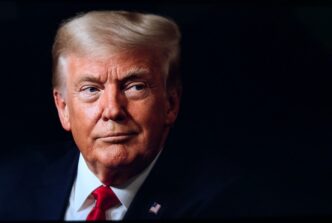President Donald Trump and his advisers have long claimed that their strategy was to employ the threat of substantial tariffs as a negotiating tool. The goal was to compel nations to engage in trade discussions—though plans for China remain more stringent. Trump’s recent decision to temporarily delay his “reciprocal” tariffs provides a mere 90-day window for his administration to negotiate intricate trade agreements with numerous countries purportedly eager to come to the table. However, financial markets remain skeptical. Market volatility has been high, with stocks swinging sharply. Other indicators, like oil, bonds, and the dollar, suggest a prevailing doubt about the feasibility of Trump’s approach.
Equity markets experienced a noticeable sell-off on Thursday, though futures showed a modest recovery by Friday morning. Dow futures rose by 115 points, or 0.2%, while S&P 500 and Nasdaq futures increased by 0.3% and 0.4%, respectively. Yet, the markets remain on edge, with any new tariff-related announcements from the Trump administration poised to cause further fluctuations. Notably, stocks dropped significantly after the administration clarified the extent of China’s massive 145% tariff, which had been previously understood to be 125%, causing the Dow to plummet over 2,000 points at one stage.
Meanwhile, the bond market is deviating from usual patterns. Generally, bonds are a safe haven during times of instability, yet US Treasuries are seeing declining prices. This reflects a loss of confidence in US trade policy, with fears that the US might endure more harm than the countries targeted by the tariffs. Treasury yields have climbed to 4.4% from under 4% earlier in the week, a significant market shift. These rising yields could impact the economy, influencing consumer loans tied to these rates.
In the oil market, prices are behaving as though a recession is imminent. Over the past weeks, oil prices have dropped sharply due to concerns that Trump’s trade policies might weaken demand for travel and transportation, sectors heavily reliant on fuel. US oil prices have dipped to around $60 a barrel, nearing a four-year low, while Brent oil hovers at approximately $63 a barrel. Historically, oil prices have been recession indicators, as seen during the financial crisis in 2008 and the recent pandemic.
Additionally, the dollar hit its lowest point in three years on Friday. Generally, tariffs boost a local currency’s value by encouraging domestic consumption over imports. However, currency traders have pulled back from the dollar, predicting that the US will suffer the most from the fallout of Trump’s tariffs, leading to a weakened position. The dollar fell to its weakest against the euro since 2022, with the dollar index dropping significantly over two days.
Despite widespread market doubts, the Trump administration remains hopeful about the prospects for negotiating bilateral trade deals with numerous countries. Treasury Secretary Scott Bessent recently indicated that over 70 countries have sought discussions with US representatives to alleviate the pressure of tariffs. While the administration has not disclosed which countries are involved, it intends to prioritize allies like South Korea and Japan. However, crafting comprehensive trade deals is a lengthy process, often requiring years to finalize.
China remains a central player in this scenario. With US tariffs on Chinese goods sitting at a staggering 145% and China imposing retaliatory tariffs of 125%, the economic confrontation between the two nations is intense. Both economies are poised to suffer significantly, and neither side appears willing to de-escalate. Though China has expressed willingness to negotiate, it insists on respectful terms.
Economists remain skeptical about the potential benefits of Trump’s abrupt shift in strategy. While successful trade agreements could bolster the economy, much damage has already been inflicted, according to Wall Street analysts. Key tariffs, including a 10% universal rate and 25% on various imports, remain active. Consequently, financial institutions like JPMorgan and Goldman Sachs suggest there’s an even chance of the US and global economies slipping into recession this year.
The Bottom Line
The current state of trade negotiations under President Trump may have significant implications for various sectors and consumers. If successful, renegotiated trade agreements could enhance economic stability and ease burdens on industries reliant on international trade. Conversely, the ongoing uncertainty and existing tariffs present challenges, potentially leading to higher costs for consumers and strained international relations.
In particular, the fluctuations in oil prices and Treasury yields could directly affect transportation costs and consumer loans, impacting household budgets and financial planning. For local businesses, the volatile dollar and trade uncertainties could influence pricing strategies and profitability, as companies navigate a shifting global landscape.
Ultimately, as the administration endeavors to implement its trade vision, individuals and businesses must remain vigilant, ready to adapt to the evolving economic terrain. The road ahead involves balancing optimism with caution, as the outcomes of these negotiations will likely shape the economic environment for years to come.








